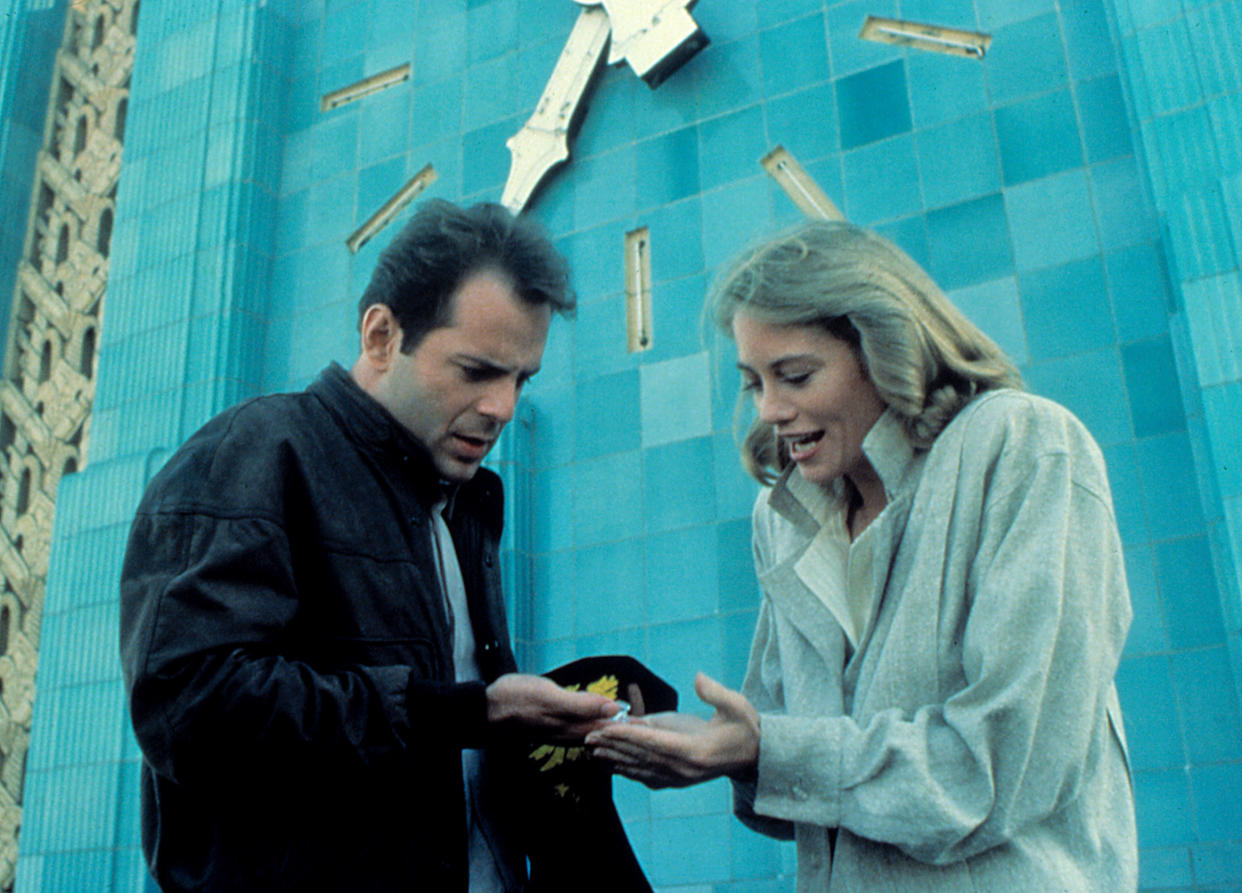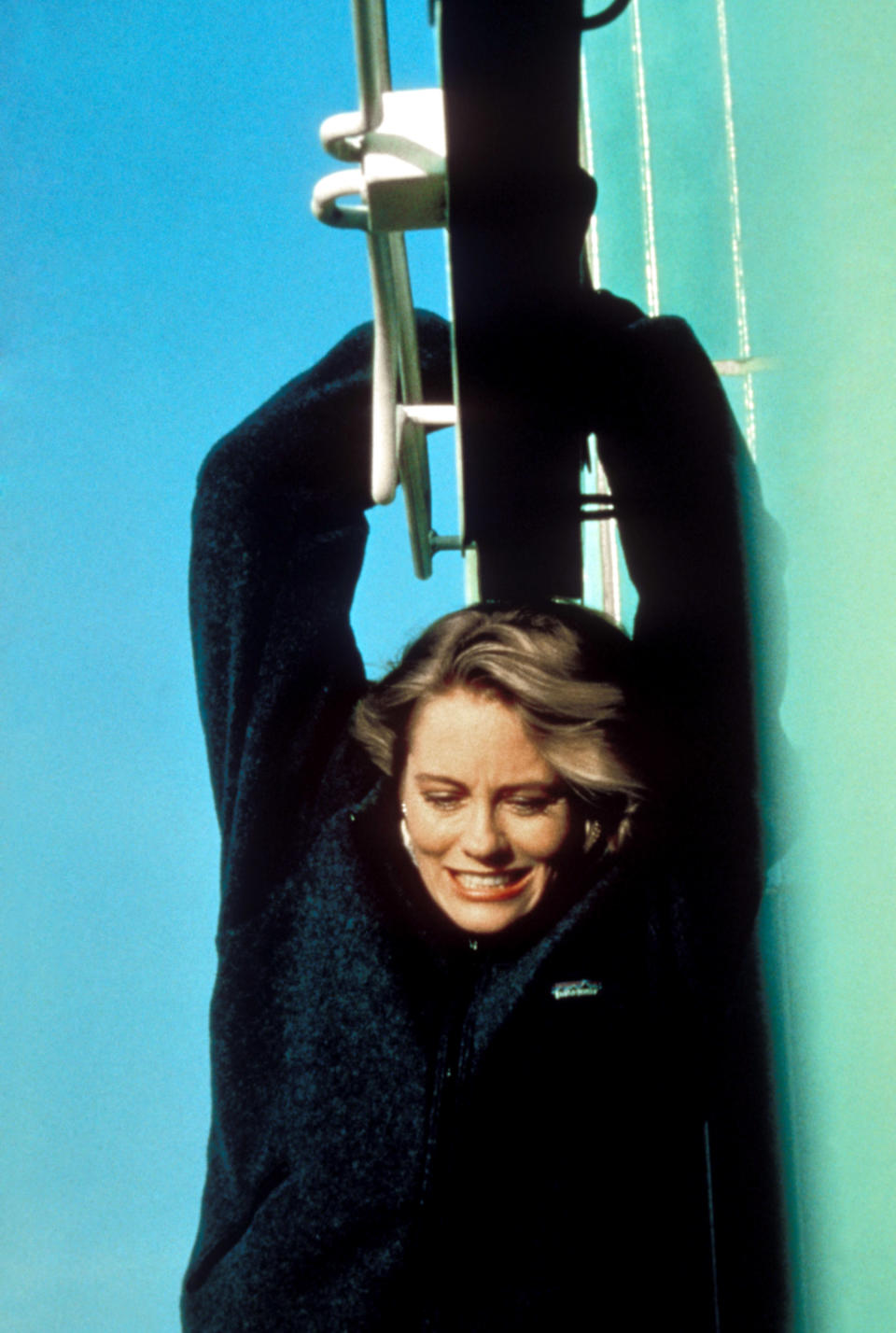‘Moonlighting’ Dangled Bruce Willis and Cybill Shepherd Off a Building for Its Very First Episode — Here’s How

- Oops!Something went wrong.Please try again later.
- Oops!Something went wrong.Please try again later.
- Oops!Something went wrong.Please try again later.
- Oops!Something went wrong.Please try again later.
When “Moonlighting” premiered on ABC on March 3, 1985, with a two-hour movie, all the ingredients for what a blockbuster the show became were in place. Cybill Shepherd and Bruce Willis had undeniable chemistry; the verbal dexterity was on full display; and the ingredients for what would become the show’s signature physical comedy was there in the climactic moment at the airport. No, wait, at the top of the Capitol Records building. No, no, it was at the top of the Eastern Columbia Building in downtown Los Angeles. The full sequence is one of the most thrilling, vertigo-inducing action moments of any TV series then or today, as audiences are discovering now that “Moonlighting” is streaming on Hulu. Not only is the building itself gorgeous, but as reluctant new partners in a detective agency on their first case, Shepherd and Willis dangle over the edge and clamber onto a horizontal ladder directly over downtown L.A. traffic. And it was all done on location
“For a long time, it was a sequence that took place at an airport with people running on runways and under planes and all kinds of stuff,” the show’s creator, Glenn Gordon Caron, told IndieWire in a recent interview. “And then I thought, ‘Oh, I’m going to write this for the top of the Capitol Records building. And that was the original concept, and then we realized architecturally, it wouldn’t actually support people and things. Mind you, I hadn’t figured out how this would feed into the plot. It was sort of [Alfred Hitchcock saying], ‘Mount Rushmore. That’ll be the end of North by Northwest.’”
More from IndieWire
Instead, the creative team landed on the art deco magnificence of the Eastern Columbia Building. The building’s clock tower ended up offering the production a few distinct advantages in making magic (and inciting panic in those afraid of heights).
“That clock appears on all four sides,” Caron said. “The one directly over the street has nothing under it, so it’s a sheer drop. But the other three have rooftops. So you now pick up two production advantages: One is you can follow the sun around all day. The other, obviously, is you can take people like Bruce Willis and Cybill Shepherd and put them up there, and while you’re still putting them in some degree of jeopardy, it’s not outrageous, malicious danger. You can build platforms and do all kinds of things.”
“I was terrified. I was completely and totally terrified,” Shepherd told IndieWire about filming the sequence. “I remember, in complete terror, grabbing the back of the director of photography’s leather jacket and saying, ‘I’m terrified, I can’t do this!’ And he took out his headphone from one side and said, ‘Excuse me, did you say something?’”

Shepherd went on to film the scene all six days “Moonlighting” spent at the top of the Eastern Columbia Building (out of 27 days of filming), although her hairdresser stoutly refused to make the trip to the top and her makeup artist passed her lipstick in a Kleenex box from his precarious perch. And with the exception of a stuntwoman scaling the wall of the building, that’s Shepherd you see in every shot.
“I don’t think I realized how ambitious it was until we were actually doing it,” Caron said. “Until you see human beings up there and you realize, ‘Oh damn, if something goes wrong, I’m the idiot that had this idea.’”
In many ways, that’s another aspect of “Moonlighting” that was already there from the pilot on. The show became famous (and then infamous) for its chaotic set, ridden with tabloid drama, missed deadlines, and structural daring that remains rare even in TV’s platinum age. The black and white and iambic pentameter episodes remain justly celebrated, but there was also an early example of a clip show featuring gossip columnist Rona Barrett interrogating Maddie (Shepherd) and David (Willis) as to why they can’t manage to complete an episode on time.
In quintessential “Moonlighting” (and Caron) fashion, the episode was a stroke of genius at the last minute, “I was standing in a valet line one night, and I looked up ahead, and I saw this little, tiny woman who I realized was Rona Barrett. And Rona Barrett was as big as TMZ is today,” Caron said. “And the front of the National Enquirer every week was how Cybill hated Bruce and Bruce hated Cybill, and Cybill threw a chair at me, and you know, all that nonsense. So I went up to Rona Barrett. I introduced myself. I said, ‘Would you be interested in being on “Moonlighting”?’”
When Barrett said yes, Caron told her to be at the studio the next morning at 6 a.m. and they went on to film her interrogating Maddie and David basically live. Fitted with earwigs, Caron fed the actors lines. The resulting episode is a meta-commentary on not just the tumultuous relationship between Maddie and David but between Shepherd and Willis, making what might have been a Hail Mary into something much more memorable. “It wasn’t as if it was an idea that I had been walking around with for months, trying to figure out how to do it,” Caron said. It was literally born standing there on that line waiting to get my car because I knew we weren’t gonna have an episode.”
Likewise, the change in location from an airport to the Capitol Records building to the Eastern Building didn’t require much tinkering of the story, despite the clock tower being an integral factor in the mystery.
“The dirty little secret of the [pilot] script is that it borrows a little bit from ‘Marathon Man,’” Caron said. “The thing I was sort of least concerned with but most worried about was the plot. To me, the whole thing was an excuse to put these two people together and create a piece of architecture that would support them for four or five or six years [of a series]. Then I sort of needed a raison d’etre, and that became the jewels and all that.”
Famously, Shepherd recognized hallmarks of classic Hollywood screwball comedies in the pilot script that even Caron didn’t know, and she understood what was being offered to her. While Howard Hawks comedies like “His Girl Friday” were most often used as a comparison, a Preston Sturges film also influenced Shepherd: “Sullivan’s Travels.”
“It was just one of those films where they were taking chances,” Shepherd said. “I’d seen that, and I thought it was possible to be beautiful and blonde and funny and not what you would expect someone who looked like me to be.”
Shepherd proved that over and over again in the pilot and over the course of all five seasons, sliding through suds, taking a pie to the face, and generally tackling physical comedy with glee.
“You had to be really ready for anything on ‘Moonlighting,’ and everybody was,” she said. “It was a game changer for my whole life, ‘Moonlighting.’”
All five seasons of “Moonlighting” are now streaming on Hulu.
Best of IndieWire
Martin Scorsese's Favorite Movies: 80 Films the Director Wants You to See
The Best Animated Series of All Time: 'Daria,' 'Cowboy Bebop,' 'Scott Pilgrim Takes Off,' and More
The 62 Best Animated Movies of the 21st Century, from 'Marcel the Shell' to 'The Boy and the Heron'
Sign up for Indiewire's Newsletter. For the latest news, follow us on Facebook, Twitter, and Instagram.

